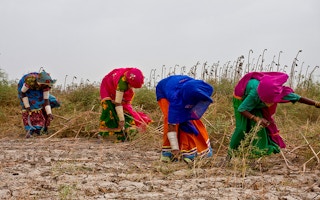Most of Tajammul Abbas’s 17 acres of farmland produces nothing but fodder for his buffalo and three goats. His land, and that around him in Punjab province, depends on rain to grow crops and rainfall has become much more uncertain as climate change takes hold, leading to lost harvests.
But things are now looking more promising for him and for about 384,000 other people living in the Pind Dadan Khan-Khushab area, three hours drive from Lahore, Punjab’s capital, after the government on Friday announced plans to build an irrigation system for the area.
The effort is expected to convert 68,000 hectares of minimally productive farmland to full production, using water from the Jhelum River.
The Asian Development Bank (ADB) on Friday approved a $275 million loan for the project, which is supported by the Indus River System Authority (IRSA), a government agency that oversees water sharing between provinces.
“Having a sufficient and effective irrigation system is fundamental in the development of Pakistan’s agriculture sector, a significant driver of the country’s economy,” said Ryutaro Takaku, a water specialist at the bank’s Central and West Asia Department.
The project “will help increase agricultural production and improve food security in Pakistan”, he noted in a press release.
Agriculture contributes 20 per cent of Pakistan’s gross domestic product and employs 42 per cent of the labour force, with Punjab province producing more than 80 per cent of agricultural output, according to Pakistan Economic Survey data.
Pakistan’s semi-arid climate means more than 90 per cent of harvests depend on irrigation through the Indus Basin Irrigation System, which draws water from the Indus River.
However, about 20 per cent of the country’s cultivable area – including the project area, bounded by salt hills on the northwest and the Jhelum River in the southwest – is outside the system.
“
Such associations and committees have been very helpful in some other areas of the country in managing watercourses and collecting water charges from users.
Muhammad Javed Iqbal Goraya, water expert, South Asian Conservation Network
Making ends meet
Abbas, who farms in the area, said a growing lack of water for crops has made surviving on the land increasingly difficult.
“We are barely making ends meet. We have had only 2,800 kilograms of wheat from two acres of land. The rest of our land remained uncultivated. We have a small stock of animals, some of whom we sell whenever we can,” Abbas told the Thomson Reuters Foundation in a telephone interview from Soduwall, his village.
The 40-year-old said one of his brothers has joined the army and another has gone abroad for work, thanks to a lack of income from the farm. His wife, he said, has to walk two hours each day to fetch water in the arid area.
Officials said the irrigation project will involve building a 117-kilometre canal to carry water diverted from the Jhelum River, 97 kilometres of secondary canals, and a range of other structures – some of which may require those now living on the land to relocate.
The system aims to catch floodwater and monsoon runoff at heavy rainfall times of the year and channel it into the irrigation network.
“There are about 128 structures that would need to be dismantled and land will have to be bought from people for the irrigation system. But there is no other option,” said Muhammad Javed Iqbal Goraya, a water expert with South Asian Conservation Network, a non-governmental organization.
In an area with poor rainfall, “irrigation (is) essential for crop production. The irrigation network will help the farmers in the area to adapt to climate changes and have more crops,” he said.
The area, if irrigated, could grow wheat, cotton, rice, sugarcane, maize, and other crops, said Goraya.
The project will introduce advanced technologies such as laser land leveling and high-efficiency irrigation, according to the ADB press release. About 6,000 farmers also will have the opportunity to learn climate-smart agriculture practices and more profitable farm management, the release said.
Goraya said that managing the new water resource and existing water with care will be key to ensuring the sustainability of agriculture in the area.
The project envisions 485 water user associations being formed to have a say in planning, designing and constructing the new irrigation system.
“Such associations and committees have been very helpful in some other areas of the country in managing watercourses and collecting water charges from users,” Goraya said.
For landholders such as Abbas the new irrigation system offers promising new opportunities.
“Water through this system will be like gold,” Abbas predicted.
(Reporting by Waqar Mustafa; editing by Laurie Goering. Republished from the Thomson Reuters Foundation, the charitable arm of Thomson Reuters, that covers humanitarian news, climate change, resilience, women’s rights, trafficking and property rights. Visit http://news.trust.org/climate)










